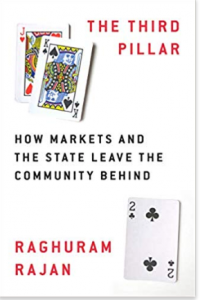
Socio-economic consequences of globalisation


Economist Raghuram Rajan’s The Third Pillar, describes an ongoing struggle for balance between the three building blocks of a good society Market, State and Community. Rajan tells us what’s needed to shift our prospects in favour of technological progress that empowers and enriches the many, away from political anger and estrangement.
Rajan was awarded the Director’s Gold Medal as the all-round student while studying electrical engineering at IIT, Delhi, and later joined Tata Administrative Services as a management trainee after IIM-Ahmedabad and in 2005, in a paper, Rajan predicted the 2008 global meltdown, which came true.
According to Rajan “These are dangerous times”, “ if people have lost faith in their ability to compete in markets, if their communities continues to decline, if they feel that the elite has appropriated all opportunities for themselves… popular resentment can turn to rage”.
His academic position at the University of Chicago, has won a reputation as a teller of uncomfortable economic truths, notably via 2005 speech predicting elements of the global financial crisis that hit a few years later. He returned to India to become central bank Governor only to clash with extreme nationalist supporters of Prime Minister Narendra Modi, and left abruptly in 2016 just after a single term in post.
His book also discusses how government and commerce often grown in reaction to one another, creating more integrated national markets. The rising of commercial powers often pushed back against the state, as it happened in Britain’s Glorious revolution of 1688, when urban merchants and rural gentry united to depose Catholic King James II.
Democracy aids competitive markets by curbing cronyism and excessive commercial interests.
Community ties can be more efficient than markets or government alone, as when small community banks turn out to be more willing to lend to entrepreneurs than big financial institutions. Yet communities can also “withdraw their support for markets” in the face of economic adversity or rapid technological change.
According to Rajan the average listed US company is three times larger today than it was a few decades ago, despite inflation, while several industries such as banking and retail show signs of declining competition.
Professionals in areas of medicine and law create “island of Privilege” by manipulating government rules and occupational licences to protect themselves from the forces of automation and globalisation that have the lower skilled workers. Rajan suggests that local communities should be given more control over programmes to help those who lose jobs or need retraining. He also suggests to tweak rules to decentralise power and aid mixed communities by giving tax benefits to rich parents who send their kids to schools in poor neighbouthoods.
He also suggests tougher rules should limit the ability of businesses to buy out smaller rivals, especially if any deal aims mostly to deadlock potential future competition, a tactic often used by Big Tech giants such as Google.
Intellectual property rules should be made less generous given that they tend to benefit large media and pharmaceutical companies at the expense of innovation.
Rajan also suggests antitrust authorities should act to stop excessive dominance of market, even if it benefits consumers as would be the case with Amazon as they ditched its New York office in the face of fierce community backlash.
The Third Pillar: How Markets and the State Leave the Community Behind by Raghuram Rajan, Penguin Press $30, 400 pages.
